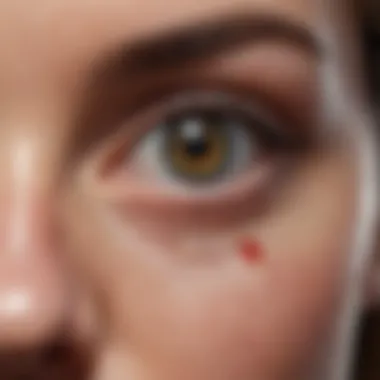Berberine Eye Drops: Therapeutic Applications and Science


Intro
Berberine eye drops represent a fascinating intersection of ancient herbal medicine and modern ocular health. For centuries, berberine has been celebrated in traditional practices for its myriad health benefits. Recently, researchers have begun to explore its potential as a therapeutic agent for eye conditions. This article aims to shed light on the formulation, efficacy, and safety of berberine eye drops, offering valuable insights into their applications in contemporary medicine.
Key Concepts
Definition of the Main Idea
Berberine is a bioactive compound found in various plants, including Berberis species. It exhibits a range of pharmacological activities, such as anti-inflammatory, antimicrobial, and antioxidant effects. The application of berberine in eye drops is rooted in these properties, potentially addressing conditions like infections, inflammation, and dryness in ocular tissues.
Overview of Scientific Principles
At the molecular level, berberine operates through multiple pathways. It can modulate cellular functions and exert protective effects by influencing inflammation and oxidative stress pathways. This compound's target is often related to its interaction with specific receptors and enzymes involved in the ocular environment. Understanding these principles is critical for evaluating the effectiveness of berberine as an ocular treatment.
Current Research Trends
Recent Studies and Findings
A growing body of research is investigating the therapeutic potential of berberine eye drops. Recent studies have indicated that these drops can significantly reduce inflammation and enhance healing in various ocular conditions. One notable study published in a peer-reviewed journal highlighted the impact of berberine on corneal health, demonstrating improved recovery rates in subjects treated with berberine-infused solutions.
Significant Breakthroughs in the Field
Breakthroughs in the formulation of berberine eye drops have enhanced their stability and bioavailability. Researchers are focusing on optimizing the concentration of berberine and employing advanced delivery systems to ensure effective penetration into the ocular tissues. Such advancements open new avenues for addressing complex ocular conditions more effectively.
"Incorporating innovative strategies in the development of berberine eye drops can significantly enhance their therapeutic outcomes and safety profile."
"Incorporating innovative strategies in the development of berberine eye drops can significantly enhance their therapeutic outcomes and safety profile."
This emphasis on research highlights the importance of continual exploration into the potential benefits berberine holds for eye health. It also underscores the need for rigorous clinical trials to further substantiate these findings and ascertain the long-term safety and efficacy of berberine as a treatment option.
Overall, the exploration of berberine eye drops stands as a promising avenue in ocular therapeutics. As research progresses, these compounds may offer new solutions for individuals suffering from a variety of eye-related ailments.
Prelims to Berberine Eye Drops
The topic of berberine eye drops is significant and gaining attention in the realm of ocular health. With an increasing focus on natural and alternative therapies, berberine presents an interesting case for exploration. This section introduces berberine eye drops and illuminates their potential therapeutic benefits, as well as considerations for their use.
Definition of Berberine
Berberine is a bioactive compound extracted from various plants, including Berberis vulgaris, commonly known as barberry. It belongs to the class of isoquinoline alkaloids and is characterized by its bright yellow color. Berberine has a long history of use in traditional medicine systems, particularly in Asian cultures. It has been credited with multiple health benefits, including anti-inflammatory and antimicrobial properties. As a result, its application in eye drops marks a novel approach to address specific ocular conditions.
Historical Context of Berberine Use
Throughout history, berberine has played a role in traditional medicine. Records suggest its use dates back centuries, particularly in Chinese and Ayurvedic practices. Historically, berberine has been used to treat various ailments, including infections and gastrointestinal issues. The transition of berberine from traditional applications to modern formulations, such as eye drops, reflects an evolving understanding of its therapeutic potentials.
"The applications of berberine in traditional medicine contextually highlight its importance in current pharmacological studies."
"The applications of berberine in traditional medicine contextually highlight its importance in current pharmacological studies."
As research continues, the interest in berberine’s effective use in ocular health grows. Understanding the past allows for an improved grasp of its formulation and applications in modern medicine, which is crucial for further developments in this area.
Chemical Properties of Berberine
Understanding the chemical properties of berberine is crucial in comprehending its potential therapeutic applications, especially in eye care. Berberine is a bioactive compound known for its wide range of biological activities. Its molecular structure and mechanisms of action significantly contribute to its efficacy. Researchers are interested in these properties to exploit berberine's benefits in ocular health.
Molecular Structure


Berberine is an isoquinoline alkaloid with a complex molecular structure characterized by the formula C208NO4. It has a distinctive yellow color and exists in a crystalline form. The structure consists of a quaternary ammonium group, a phenolic group, and multiple aromatic rings. These features are crucial for its interaction with biological molecules.
- Quaternary Ammonium Group: This group imparts a positive charge to the molecule. It helps berberine bind to negatively charged cell membranes, enhancing its cellular uptake.
- Phenolic and Aromatic Rings: They provide antioxidant properties, allowing berberine to scavenge free radicals. This may protect ocular tissues from oxidative stress, a significant factor in various eye disorders.
Understanding the molecular structure can aid in developing new formulations and improving the utilization of berberine in eye drops.
Mechanism of Action at Cellular Level
Berberine exhibits its effects through several mechanisms. First, it influences various cellular pathways. It activates adenosine monophosphate-activated protein kinase (AMPK), which plays a key role in cellular energy regulation. This activation can lead to helpful outcomes like reduced inflammation and improved cell metabolism, both beneficial for maintaining ocular health.
Second, berberine possesses anti-microbial properties. It disrupts the cell membranes of pathogens, making it effective against certain bacterial and fungal infections that could affect the eyes. Third, its antioxidant properties help combat oxidative stress, reducing the risk of conditions such as cataracts and age-related macular degeneration.
"The dual action of berberine—antioxidant and antimicrobial—positions it as a formidable contender in developing new ocular treatments."
"The dual action of berberine—antioxidant and antimicrobial—positions it as a formidable contender in developing new ocular treatments."
In summary, the chemical properties of berberine underscore its potential as an innovative treatment modality for eye health. Understanding these properties allows researchers and healthcare professionals to explore optimal applications in ocular therapies.
Formulation of Berberine Eye Drops
The formulation of berberine eye drops plays a crucial role in maximizing their therapeutic potential. This section focuses on the significance of understanding the ingredients and their proper preparation methods. Adequate formulation not only ensures stability and bioavailability but also enhances the overall efficacy of the drops.
Ingredients and Composition
The ingredients used in berberine eye drops can largely dictate their performance and safety profile. Common components of these drops include:
- Berberine Hydrochloride: This primary active ingredient is responsible for the therapeutic effects. It has anti-inflammatory and antimicrobial properties, making it suitable for treating various eye conditions.
- Buffers: To maintain the pH balance of the eye drops, buffers such as sodium phosphate are included. This is essential for ensuring comfort upon application.
- Preservatives: Certain preservatives may be necessary to prevent microbial contamination, allowing for a safe shelf life. However, it’s crucial to select preservatives that do not cause irritation to the eyes.
- Vehicle Solution: Often, a sterile saline or other isotonic solutions serve as a vehicle, ensuring the proper delivery of the active ingredients to ocular tissues.
These ingredients must be finely tuned to create a product that is not only effective but also tolerant for the sensitive ocular environment.
Preparation Methods
The preparation of berberine eye drops involves specific methods to ensure the highest quality product. Key processes typically include:
- Dissolution: The berberine compound is dissolved in a suitable solvent at a controlled temperature to ensure complete solubility.
- Mixing: The dissolved berberine is then carefully mixed with other ingredients to achieve a homogenous solution. This step is critical as it directly affects the consistency of the final product.
- Filtration: To remove any particulates or contaminants, the solution is usually filtered. This step is vital for ensuring the sterility of the eye drops.
- Filling and Packaging: The prepared solution is filled into sterile, light-resistant dropper bottles. This preserves its efficacy and prevents degradation of the active ingredients.
Proper attention to these preparation methods is indispensable. Each step's precision affects the final product’s quality and usability. The formulation process thus embodies both science and artistry, ensuring berberine eye drops are effective and safe for ocular application.
Therapeutic Applications of Berberine Eye Drops
The exploration of therapeutic applications of berberine eye drops is a critical aspect of understanding this innovative treatment. With growing interest in natural compounds for ocular health, examining the specific benefits and applications of berberine is essential. Berberine, a bioactive alkaloid, has shown potential to beneficially impact various eye conditions through its anti-inflammatory and antimicrobial properties. This section will delve into the potential benefits for ocular health and the clinical uses in various eye disorders.
Potential Benefits for Ocular Health
The potential benefits of berberine eye drops for ocular health are worthy of consideration. Studies suggest that berberine may help reduce inflammation and oxidative stress in the eye. Inflammation is a significant contributor to several eye diseases, including dry eye syndrome and uveitis. Berberine’s antioxidant properties can combat free radicals, which are harmful compounds that can cause cellular damage.
Additionally, healing aspects of berberine may contribute to improved corneal health. This could provide longer-lasting effects, particularly for diseases where corneal integrity is vital, like keratitis. Enhanced tear production due to increased natural lubrication can reduce discomfort associated with dry eyes. Furthermore, some research indicates that berberine can intervene in bacterial pathogenesis, offering a possible preventive or therapeutic approach for infections affecting the ocular surface.
"The use of berberine eye drops holds promise as a natural alternative to address various eye health issues."
"The use of berberine eye drops holds promise as a natural alternative to address various eye health issues."
Clinical Uses in Eye Disorders
The clinical applications of berberine eye drops are expanding as research uncovers their therapeutic potential. In recent years, healthcare professionals have explored these drops for conditions like glaucoma, dry eye syndrome, and conjunctivitis. Each disorder presents unique challenges that berberine could help address more effectively compared to traditional treatments.


- Glaucoma: Berberine may aid in lowering intraocular pressure, a critical factor in managing this disease. Its neuroprotective effects could also support optic nerve health, contributing to long-term treatment strategies.
- Dry Eye Syndrome: For this prevalent condition, berberine can be more favorable than conventional therapies. It can increase tear production and shield the ocular surface, which can enhance overall comfort and reduce inflammation.
- Conjunctivitis: Berberine’s antimicrobial properties equip it to address infections caused by bacteria or viruses. With limitations in conventional antibiotics, berberine provides an alternative option with potentially fewer side effects.
In summary, the therapeutic applications of berberine eye drops signify a shift towards integrating natural remedies into modern ocular health practices. The benefits suggested by current research pave the way for a deeper exploration of how berberine can serve as an effective treatment modality in clinical settings.
Research Landscape and Studies
The relevance of the research landscape regarding berberine eye drops cannot be overstated. Understanding the studies conducted in this field helps elucidate the potential therapeutic roles that berberine may play in ocular health. This particular section encompasses various aspects, including the outcomes of recent clinical trials, along with a summary of published research findings that underpin the discourse surrounding berberine's efficacy and safety.
A comprehensive analysis of existing literature is essential. This informs both clinicians and researchers about the current state of knowledge and could pave the way for innovative treatment paths. The ongoing exploration is critical, as it highlights both the opportunities and the limitations present in the application of berberine for eye care. Given the current medical climate, with a growing emphasis on alternative therapies, this area warrants continuous investigation.
Recent Clinical Trials
Recent clinical trials concerning berberine eye drops have focused on various parameters. These include the safety, efficacy, and optimal dosage for treating specific eye conditions. For instance, several studies have examined how berberine affects inflammatory processes in the eye, as well as its potential role in managing diseases like dry eye syndrome.
- One study investigated the anti-inflammatory effects of berberine in patients with keratitis, observing notable improvement in symptoms and overall eye health.
- Another trial explored the impact of berberine on intraocular pressure, particularly for glaucoma patients, yielding promising results related to pressure reduction.
Such trials serve as a foundation for establishing berberine as a potential therapeutic agent in ocular medicine. They are instrumental in determining whether further research should continue along these lines.
Published Research Findings
The published research on berberine eye drops reveals significant insights that reinforce the therapeutic prospects of this compound. Many studies focus on berberine's bioactivity and how it interacts within the ocular environment.
Key findings include:
- Antibacterial Properties: Research indicates that berberine exhibits antibacterial effects, potentially useful for treating bacterial conjunctivitis.
- Antioxidant Activity: Studies demonstrate berberine's ability to combat oxidative stress, which is closely linked to various eye disorders, including age-related macular degeneration.
- Mechanisms of Effect: Investigations into the cellular mechanisms show the ways berberine can modulate inflammatory pathways, creating a beneficial effect in the treatment of ocular inflammation.
"Understanding the pharmacological effects of berberine is crucial for advancing its application in eye care."
"Understanding the pharmacological effects of berberine is crucial for advancing its application in eye care."
These findings emphasize the necessity for ongoing research. Each discovery adds a layer of complexity to the narrative surrounding berberine eye drops while also enhancing their potential adoption in clinical practice.
Thus, the convergence of clinical trials and published studies sets the stage for a promising future for berberine as an ocular treatment.
Safety and Toxicology of Berberine
The safety and toxicology of berberine are critical elements to consider in the context of its use as an ocular treatment. As berberine gains prominence in eye care, understanding its safety profile becomes essential for both users and healthcare professionals. Ensuring that a substance is safe for application in delicate areas like the eyes protects against potential adverse effects and assures efficacy in therapeutic settings.
This section examines adverse effects and contraindications associated with berberine eye drops, as well as best practices for dosage and administration, providing a thorough insight into the implications of this compound in ocular health.
Adverse Effects and Contraindications
While berberine is generally considered safe in traditional applications, its use in eye drops is relatively novel, and specific adverse effects must be highlighted. Some users may experience irritation or allergic reactions upon instillation. Symptoms can include:
- Redness
- Itchiness
- Swelling
- Tearing
Some individuals may face contraindications due to existing health conditions. For instance, people with a history of hypersensitivity to berberine or related compounds should avoid its use. Also, pregnant or breastfeeding women should consult healthcare providers before using berberine eye drops, as there are insufficient studies on long-term effects in these groups.
It is crucial for users to monitor any unusual symptoms after application and seek medical advice if adverse effects persist.
It is crucial for users to monitor any unusual symptoms after application and seek medical advice if adverse effects persist.
Recommended Dosage and Administration
Establishing a recommended dosage for berberine eye drops is key in maximizing their benefits while minimizing risks. Current research suggests that a concentration of berberine between 0.5% to 2.0% may be effective in garnering therapeutic effects without significant side effects. As for administration, users are generally advised to follow these guidelines:
- Consult a professional before starting treatment.
- Start with one drop in the affected eye, once or twice daily.
- Adjust frequency based on tolerance and response, but do not exceed three times daily without medical guidance.
- Avoid mixing with other ocular medications unless recommended by a healthcare provider.


Monitor the response closely and report any persistent discomfort or changes to a healthcare provider. This careful approach will help ensure that users achieve the best possible outcomes from berberine eye drops while addressing any safety concerns that may arise.
Comparative Analysis with Other Ocular Treatments
The comparative analysis of berberine eye drops with other ocular treatments is essential for understanding their potential role in modern eye care. As eye disorders continue to affect millions, it is crucial to evaluate the efficacy, safety, and overall benefits of various treatment options. This section will focus on two primary areas of comparison: berberine eye drops versus conventional eye drops, and the exploration of emerging alternatives in ocular therapy.
Berberine vs. Conventional Eye Drops
Berberine eye drops represent a novel approach to the treatment of ocular conditions, differing significantly from traditional eye drops like preservative-based solutions or steroidal drops. Some key differences include:
- Mechanism of Action: Berberine may operate through multiple pathways, including anti-inflammatory and antimicrobial effects, which are not commonly seen in conventional treatments.
- Side Effects: Conventional eye drops often contain preservatives that can cause irritation or allergic reactions. In contrast, berberine eye drops may present a better safety profile, although this requires further investigation.
- Natural vs Synthetic: Berberine is a naturally occurring compound found in several plants, leading to a growing interest in its therapeutic potential compared to synthetized compounds in conventional drops.
The limited available clinical evidence suggests that berberine eye drops could be beneficial for conditions like dry eye, conjunctivitis, and other inflammatory disorders commonly treated with conventional drops. However, robust clinical trials are necessary to substantiate these claims and establish standardized treatment protocols.
Emerging Alternatives in Ocular Therapy
Innovation in ocular treatment is ongoing, with various alternatives emerging alongside berberine. Some noteworthy alternatives include:
- Biologics: These are derived from living organisms and target specific pathways in eye diseases like macular degeneration or diabetic retinopathy. Biologics have shown promising results but may carry higher costs and risks associated with their use.
- Sustained-release Systems: New technologies are being developed for the sustained release of medication in the eye. These systems may provide better compliance and effectiveness by maintaining therapeutic levels for longer periods.
- Microdosing Techniques: This method delivers smaller doses of medication directly to the affected site. Microdosing can reduce systemic exposure and side effects, making it an attractive option for patients.
In summary, while berberine eye drops are an emerging option, the comparative analysis highlights the need for thorough investigation. Physicians must carefully consider these alternatives when determining the best course of treatment for their patients, weighing efficacy, safety, and technological advancements.
The Future of Berberine in Eye Care
The exploration of berberine eye drops represents a significant advancement in ocular therapeutics. As research surrounding this compound grows, its potential applications appear increasingly promising. The future of berberine in eye care will likely hinge on innovations in formulation, heightened understanding of its effects, and the wider adoption of these treatments in clinical practice. Key benefits of berberine treatments could include enhanced bioavailability, reduced toxicity, and a broad therapeutic spectrum. These aspects will be critical as the healthcare community seeks effective solutions for various ocular disorders.
Innovations in Formulation Technologies
With rapid advancements in formulation technologies, the development of berberine eye drops could be optimized for better efficacy and patient acceptability. Modern techniques such as nanotechnology and microencapsulation can increase solubility and stability of berberine, ultimately enhancing its absorption in ocular tissues. Placing berberine within liposomes or nanoparticles could create targeted delivery systems that improve therapeutic outcomes. Additionally, utilizing biodegradable polymers in the formulation can lead to prolonged release of the active ingredient, allowing for less frequent dosing, which may improve patient compliance.
Potential for Broader Applications
Berberine eye drops hold potential beyond current therapeutic uses. Future applications might target a wider range of eye conditions such as dry eye syndrome, age-related macular degeneration, and even infection-related ocular redness. Berberine’s anti-inflammatory and antimicrobial properties could be instrumental in developing new treatments for these conditions. With ongoing research, it is plausible that berberine could be combined with other treatments, creating synergistic effects that enhance patient care. As understanding deepens, the possibilities for integrating berberine into mainstream ocular therapy appear boundless.
"Innovating formulation technologies will determine the effectiveness and wider adoption of berberine eye drops in clinical practice."
"Innovating formulation technologies will determine the effectiveness and wider adoption of berberine eye drops in clinical practice."
In summary, the path forward for berberine in eye care is rich with potential. Only time and continued research will reveal the extent of its benefits in ocular health.
Ending
The conclusion serves as a pivotal component of this article, summarizing the rich insights into berberine eye drops while consolidating the information discussed throughout the sections. A well-crafted conclusion provides a valuable recap for readers, driving home the significance of the findings and underscoring the relevance of berberine as an emerging therapy in ocular care. As research continues to evolve, understanding the potential benefits and implications of berberine eye drops for ocular health becomes increasingly important.
Summary of Key Points
In this article, we have explored several critical themes related to berberine eye drops:
- Definition and Historical Context: Berberine is not a recent innovation. Its roots go deep into traditional medicine, which sets the stage for its modern applications.
- Chemical Properties: The unique molecular structure contributes to its mechanism of action at the cellular level, highlighting its potential efficacy.
- Formulation: The ingredients and preparation methods play a crucial role in ensuring the performance and stability of the eye drops.
- Therapeutic Applications: Multiple studies suggest potential benefits in treating various eye disorders, making it a promising alternative to conventional treatments.
- Research Landscape: Recent clinical trials and published research findings illustrate the active interest in this subject within the scientific community.
- Safety: Understanding adverse effects and recommended dosage is essential for safe usage in the population.
- Comparative Analysis: Evaluating berberine against conventional eye drops reveals unique advantages, expanding the discussion on emerging alternatives.
- Future Prospects: Innovations in formulation technologies and broader applications highlight the expansive potential for berberine in eye care.
The details presented provide a holistic view of the significant aspects of berberine eye drops, ensuring readers grasp the relevance of ongoing developments in this field.
Call for Further Research
The current landscape surrounding berberine eye drops certainly calls for further investigation. Areas needing attention include:
- Long-term Efficacy Studies: Ongoing research should focus on the long-term effectiveness of berberine eye drops for managing chronic eye conditions.
- Mechanistic Exploration: There is a need for additional scrutiny of the cellular mechanisms at play to fully understand how berberine exerts its therapeutic effects in ocular tissues.
- Safety Protocols: Rigorous safety assessments should be conducted to identify potential long-term adverse effects and establish clear guidelines for use in various populations.
- Diverse Population Studies: Conducting research in diverse groups could provide insights into variations in response, especially considering genetic factors that may influence efficacy.
The future of berberine in ocular health is subject to further validation through research. As the scientific and medical community continues to explore its therapeutic scope, opportunities abound to enrich the existing knowledge base with robust data.
"Expanding the research on berberine eye drops may unlock new avenues for effective treatments in ocular medicine."
"Expanding the research on berberine eye drops may unlock new avenues for effective treatments in ocular medicine."







